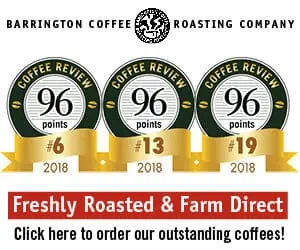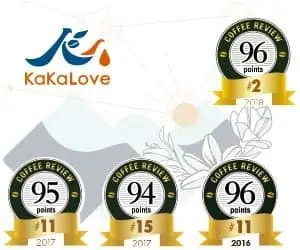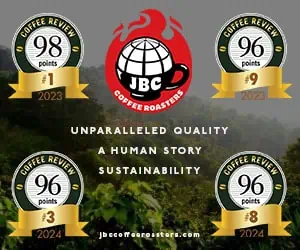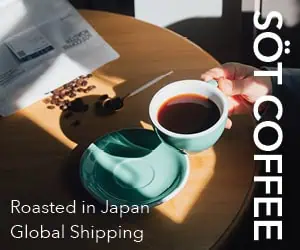This month’s collection of thirteen holiday coffees splits neatly into two categories: special proprietary holiday blends – suavely comfortable and balanced in profile – and an assortment of distinctive single-origin coffees, very high-rated and quite spectacular in sensory profile (and in some cases rather spectacular in price as well). In all cases these are seasonal coffees that are here for December and most likely gone for January.
For the holiday blends skim down to near the end of the queue of this month’s thirteen reviews. All four holiday blends we review this month came in at ratings of 90 to 91. Several other holiday blends not reviewed here attracted ratings of 89 to 90. All of these blends tended to be consistently high in quality but also consistent in their apparently modest goal: to produce a comfortable cup, not too brightly acidy, original but not intensely so, balanced and appealing to a wide variety of taste and expectations. And reasonable in price.
Which is not to say that these blends did not involve considerable achievement. The pair of two-bean blends we review here, the Tony’s Summit Winter Blend (90), with its grapy fruit, and the Velton’s Holiday Blend (90), with its Kenya pungent berry working over a rounding Java chocolate, are quite original in their blend concepts and subtly original in cup. The Grounds for Change Holiday Blend (90) and Just Love Fa-La-La-La-La (91) blends impressed not only for their drinkability and quiet distinction, but also for their environmental and social ambitions.
Holiday Splurges and Excitement
On the other hand, the single-origin coffees put forward by roasters as candidates for celebration and gift-giving appeared to pursue another goal: pure sensory surprise and exhilaration. In the case of the three coffees from trees of the rare Gesha variety reviewed here the flamboyant excitement is delivered at rather flamboyant prices. With other coffees reviewed this month, however, the excitement is considerably more affordable.
Gorgeous Gold-Plated Geshas
But for those who associate the winter holidays with voluptuous splurges on exceptional experiences nothing can beat dropping cash on coffee produced from trees of the rare Gesha variety of Arabica, the world’s most distinctive tasting coffee and the world’s most expensive coffee not processed through the digestive tract of an animal. All four of the Geshas we tested, all from Panama, were predictably striking and remarkable, attracting an average rating of 95.5. They were led by the lushly and soaringly complex dried-in-the-fruit Geshas from Barrington Coffee (Perci Red Panama Gesha, 97) and PT’s Coffee (Panama Don Pachi Natural Geisha, 96), together with the delicate, shimmeringly intense wet-processed rendition from Kéan Coffee (Panama La Esmeralda Especial, 95).
An aside: Gesha awareness received a modest media boost the week of November 26 when a Starbucks outlet in New York began offering 16-ounce cups of a Gesha from Costa Rica at seven dollars per cup. Naturally some in the blogosphere smelled blood: The tyrannical world-straddling mermaid (or, alternatively, the world of pretentious coffee snobs) rips off consumers again. A Wall Street Journal reporter did the sensible thing, which was to call a couple of us in the industry to find out what the actual coffee most likely cost Starbucks before it was roasted and brewed. It turned out, of course, once we did the math, that seven bucks is a reasonable price for a sixteen-ounce cup of a fine Gesha individually brewed in the excellent Starbucks Clover machine. As a point of comparison, the same day the reporter called me I paid around seven dollars for five ounces of a pleasing but ultimately ordinary Argentine red wine in a local restaurant. I don’t know how distinguished the particular Gesha offered at Starbucks was, but if it was anywhere near as good as the Geshas we tested for this month’s article, that sixteen ounces of Gesha packed several times as much sensory pleasure and excitement as my rather routine glass of red wine.
Reasonably Priced Holiday Coffee Splurges
Leaving the rare and expensive Geshas behind, the two next most logical and exciting choices for exceptional holiday coffees are dried-in-the-fruit Ethiopias, with their lush fruit and often brandy-toned chocolate, and classic wet-processed Kenyas from the SL28 and SL34 varieties, with their classic bright sweetness and crisp, distinctive berry and floral notes.
The dried-in-the-fruit or “natural” Ethiopias appeared to be the roasters’ favorite for this holiday season, with six samples nominated and tested, netting an average rating of 92. One roaster, Klatch Coffee, upped the ante by declaring that his dried-in-the-fruit Ethiopia Yirgacheffe is “Nick’s Holiday Favorite.” The Klatch Coffee version is reviewed here at 93; it displayed the roundly honeyed blueberry and crisp cocoa that Nick allegedly enjoys. The Blue Bottle Ethiopia Nekisse reviewed here at 94 showed a slightly sweeter, juicier side of the fruit and a softer chocolate. Both were modestly outflanked by a still sweet but somewhat deeper, more pungently complex version of the style from the Taiwanese roaster Marcheur, the Jingle Bell Natural Yirgacheffe, at 96.
Purist’s Alternatives
We also tested three fine, classically wet-processed Kenyas that impressed with an average a rating of 92. One, the soaring, exquisitely and sweetly bright Kenya Kamviu from Temple Coffee, is reviewed here at 95. Had I felt comfortable following my own subjective preferences and leaving the Coffee Review rating system and its carefully worked out calibrations behind, I probably would have assigned this coffee a rating close to 100. Slightly pricy at an equivalent of around $21 per pound, it definitely ranks as a bargain when run through my personal price-to-pleasure calculator.
Finally, we tested one of the most naturally sweet coffees I have ever cupped: A 94-rated Rwanda from Kickapoo coffee. Coffee cuppers value sweetness in coffee in part because coffee is a naturally bitter beverage and an inherent sweetness balances the structure of the cup. We also value sweetness because it is a sign of purity, a sign that the sweetness of ripe coffee fruit has made it intact into the cup without the complication of taints from unripe or overripe fruit, fermented sugars or molds. I have never tasted a Rwanda, or possibly any coffee from any origin, that made quite as powerful an argument for natural sweetness as this month’s Rwanda Abakundakawa from Kickapoo.
We added a fine, classic Colombia from Beansmith Coffee, the Colombia San Agustín Arnulfo Leguizamo reviewed at 92. Produced by a cooperative operating in the very distinguished San Agustín growing region in southern Colombia, this Colombia displays the big body and balanced acidity associated with this origin and region, along with some surprising, elegant dry berry notes of the kind we usually associate with Kenyas
Back to Price
Most of the single-origin coffees not-called-Gesha reviewed this month, despite their extraordinary quality and character, are reasonably priced by specialty coffee standards, and would seem to make the cut as high-end stocking stuffers or dinner party gifts. To return to the wine analogy, when fine wines are considered something of a holiday bargain at twenty dollars per bottle, I don’t see why most of these coffees, with their average price for a 12-ounce bag of $15, or the equivalent of $20 per pound, are not even better values, given that in my view, at least, they deliver sensory distinction analogous to a forty- or fifty-dollar bottle of wine.
Some of these coffees make a modest additional argument for themselves as holiday gifts by virtue of their packaging. The Kickapoo Rwanda was delivered in a sturdy metal can (60% recycled material) with a one-way degassing valve, a reusable metal lid and dignified, informative text and graphics. The rather pricy Blue Bottle Nekisse is sold in a small, reusable/recyclable metal can with an understated but informative brown-paper label that diffidently extends the Blue Bottle brown-bag totally recyclable aesthetic to the gift rack. And though the Klatch Coffee bag won’t dazzle any eyeballs, it’s good to discover by reading the label that this coffee was produced at 2,000 meters at the North Pole.
2012 The Coffee Review. All rights reserved.










